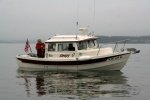There is a recounting of the coast guard hearings on g Captain at:
http://gcaptain.com/bounty-hearings-chief-mates-testifies/
By: MARIO VITTONE Comments below are either from the testimony or by the author, at times paraphrased.
This was almost a year after the loss of Bounty. Those who gave testimony were almost detached, and often contradicted what they had said in interviews right after the event.
This hearing was conducted by Commander Carroll (USCG) and Captain Rob Jones (NTSB)
Each morning the Coast Guard Commander who was in charge of the hearings would begin with the following statement:
"“This investigation is also intended to determine whether there is any evidence of any incompetence, misconduct, or willful violation of the law on the part of any licensed officer, pilot, seaman, employee, owner, or agent of the owner of any vessel involved…” The investigating officer then asked all present to stand and observe a moment of silence for those soles who were lost in this tragedy.
"Remember that the Bounty was classified: When tied to the pier and selling tours, she was operating as a “
moored attraction vessel.” That’s a phrase you won’t find in federal regulations. It exists only in Coast Guard policy. When the Coast Guard issues a vessel a Certificate of Inspection (COI) to operate as an attraction vessel, all they are assuring the public is that they should be able to walk on and off of said vessel without getting hurt. Defined in the Coast guard’s Marine Safety Manual, attraction vessel inspections are relatively easy to pass. The entire policy covering attraction vessels is just 10 pages (beginning on B4-82) and that includes the guidance to the inspectors."
When she sails between shows (where she makes money) she is not classified, because she is less than 300 gross tons--as measured. She is really over 409 measured tons, but there are tricks to get around that and achieve a rating less than 300 gross tons, which means that she is not subject to SOLAS or ABS rules. Tonnage as measured is more of interior volume--as related to carrying capacity. Maybe that is too bad--because she most likely would have not passed any inspection by SOLAS, ABS, or Coast Guard. Basically she was sailing with a paid or volunteer crew, rated at 266 gross tons, and thus not subject to any Coast Guard, SOLAS or ABS standards. She was basically classified as a recreational sailing vessel for these voyages--and thus not subject to regulations.
The insurance surveyor, was also the designer for any changes which were made to the boat--plus was a close friend of the captain. He had not observed the state of the frames, planks or caulking when she was in the shipyard. DAP 33 was used as a seam compound--it cost 1/10 of the cost of a proper seam sealant.
For example they had an emergency gasoline powered trash pump. It was pruchased in 2011 as an insurance requirement for an Atlantic Crossing. It was run once--and put back in the shipping box. The gasoline from 18 months before was still in the tank and carb. They were not able to get it to run more than 30 seconds--and no one aboard seemed to understand that gas goes bad. The excuse was "we didn't want to wear it out by practicing with it", and "gas is explosive and a fire hazard, so we didn't want to use it.". The same we didn't want to wear it out was true for the hydraulic pump and the second generator.
The summary of the hearings are interesting to read, if you have an interest in old wooden sailing ships. I grew up on a wooden boat, which is still sailing at the age I am (77 years old)--and the boat has a far better chance of making 100 years than I do. (She was surveyed by a friend of mine 3 years ago, and he found her in excellent condition--partly because she was fastened with Everdur Bronse fittings, Port Ordford Cedar Planking and heavy 4" Oak frames--spaced at 12" intervals. Most boats that age have been completely rebuilt if they have survived. I have never sailed on any of these tall ships, although I done many of the voyages that they do in my own boats (fiberglass) and have been aboard many of them at docks or anchor.

